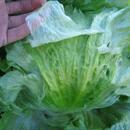All
What is E. Coli?
- An abbreviation for the bacterium Enterobacteriaceae family called Escherichia coli
- "Escherich" was the scientist who isolated the bacteria in 1885
- Many types exist—some healthy, some dangerous; the most common harmful strain is E. coli 0157:H7
- Organisms are harbored in animal and human feces
- The most common sources are ground beef and raw milk; less commonly found in produce
Typical Symptoms
- Severe abdominal cramps
- Bloody diarrhea
- Possible organ damage and/or death
Most at risk
- Young children
- Elderly and/or immunocompromised persons
How is it Spread?
- Contaminated food or water
- Person-to-person contact
- Examples:
- If an infected person does not wash his/her hands properly after using the toilet, bacteria can be passed by physical contact or by handling food
- If water contaminated with E. coli (through animal or human feces) touches food at any stage (irrigation, washing, rinsing, etc.), the food may also become contaminated
Enterococcus are naturally occurring intestinal bacteria that can be found in humans, animals, plants, soil, and water. It is one of the most commonly occurring hospital-acquired illnesses, but can also be a foodborne illness. Enterococcus faecalis is the most commonly-isolated species.
Typical Symptoms
- Fever
- Urinary tract infection
- Diarrhea
- Diverticulitis
- Meningitis (rare)
Most at risk
- Young children
- The elderly
- The immunocompromised
How is it spread?
- Most frequently spread in hospitals
- Can be spread through contaminated plants, soil, and water
-
Occasionally through person-to-person contact
- Examples:
- If an infected person does not wash his/her hands properly after using the toilet, it can be passed along by physical contact or by handling food
- If contaminated water touches food at any stage (irrigation, washing, rinsing, etc.), contamination can also occur

Usually used in reference to lettuces, epidermal peeling is a quality defect caused by freezing temperatures. The outer layer of the leaf peels away, much like chapped lips. It is a purely cosmetic defect and does not affect flavor or quality.
What is it?
E. Coli is broadly classified by O and H antigens. For instance, the most well-known E. Coli strain is O157:H7. Outbreaks involving non-O157 Shiga toxin-producing E. Coli (STEC) are rarer (or perhaps under-reported), but have been increasing since the 1990s.
How is it spread?
The bacterium can be spread person to person or by contaminated foods. The major source for humans is cattle feces.
Typical Symptoms
Symptoms are similar to those involved in E. Coli O157 (abdominal cramping, bloody diarrhea, and possible organ damage), but can also include hemolytic uremic syndrome (HUS), a life-threatening complication that can cause kidney failure. Incubation can take as long as ten days or as few as one.
Most at risk
Young children, pregnant women, the elderly, and immunocompromised persons are most at risk, but given the right conditions, anyone can suffer this illness.
For more information, see:
http://www.about-ecoli.com/non_o157_STEC/#.VFKUPfnF_d0
What is it?
Ethylene is an odorless, colorless gas that is produced naturally by fruits and vegetables. It can increase the pace at which fresh produce ripens, shortening shelf-life.
Some of the highest producers of ethylene are apples, avocados (ripe), bananas, cantaloupe, kiwi fruit, pears, and stone fruit.
Almost all fresh produce is at least somewhat sensitive to ethylene gas. In storage, be sure to isolate the high producers from the rest of your fruits and vegetables.
